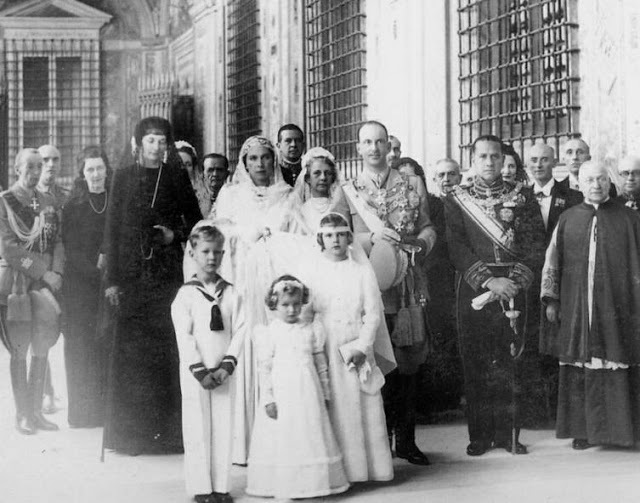Chapter 2
The Universal Scope of the Allocutions of Pius XII to the Roman Patriciate and Nobility
The Situation of the Italian Nobility in the Pontificate of Pius XII
1. Why Focus Specifically on the Italian Nobility?
In 1947 the constitution of the Italian Republic abolished all titles of nobility. (1) The last blow was thus struck against the juridical status of an age-old class – which lives on today as a social reality – and a problem, complex in all its aspects, was created.
Complexity was already perceptible in the antecedents to the issue. Contrary to what occurs in other European countries – France and Portugal, for example – the makeup of the Italian nobility is highly heterogeneous. Before the political unification of the Italian peninsula in the nineteenth century, the various sovereigns who ruled over different parts of the Italian territory all bestowed titles of nobility. This holds true for the emperors of the Holy Roman Empire; the kings of Spain, of the Two Sicilies, and of Sardinia; the grand-dukes of Tuscany; the dukes of Parma, and still others, including the patriciates of cities such as Florence, Genoa, and Venice. It is principally true – and this is of the utmost interest for the present study – of the Popes. The Popes were temporal sovereigns of the relatively extensive Papal States. They also granted titles of nobility and continued to do so even after the de facto extinction of their temporal sovereignty over these states.
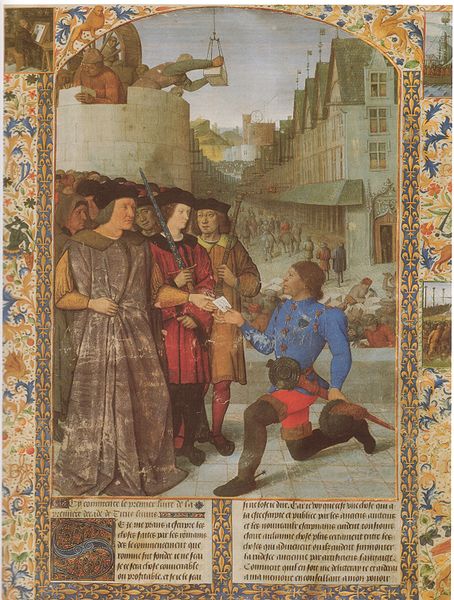 In 1870, when the unification of Italy was consummated with the occupation of Rome by Piedmontese troops, the House of Savoy attempted to amalgamate these various nobilities.
In 1870, when the unification of Italy was consummated with the occupation of Rome by Piedmontese troops, the House of Savoy attempted to amalgamate these various nobilities.
The project failed both politically and juridically. Many noble families remained faithful to the dethroned dynasties from which they had received their titles. Particularly, a considerable part of the Roman aristocracy, maintaining tradition, continued to figure officially in Vatican solemnities. They refused to recognize Rome’s annexation to Italy, rejecting any rapprochement with the Quirinal, and closed their salons as a sign of protest. To this mourning nobility was given the name “Black Nobility.”
Nevertheless, the amalgamation advanced in no small scale in the social sphere through marriages, social relations, and the like. As a result, the Italian aristocracy in our day constitutes a whole, at least from many points of view.
Article 42 of the 1929 Lateran Treaty, however, assured the Roman nobility a special status, since it recognized the Pope’s right to grant new titles and accepted those granted previously by the Holy See. [2] Thus the Italian and Roman nobilities, by then already at peace, continued to exist legally side by side.
The Concordat of 1985 between the Holy See and the Italian Republic makes no mention of this matter.
* * *
The situation of the Italian nobility – and of the European nobility in general – did not cease to be complex.
In the Middle Ages, the nobility had constituted a social class with specific functions within the State, which entailed certain honors and corresponding obligations.
During modern times this situation had gradually lost its stability, prominence, and brilliance, so that even before the Revolution of 1789, the distinction between the nobility and the people was considerably less marked than in the Middle Ages.
Throughout the egalitarian revolutions of the nineteenth century, the position of the nobility suffered successive mutilations of such extent that its political power in the Italian monarchy at the end of World War II survived solely as a prestigious tradition, which was seen, incidentally, with respect and affection by most of society. The republican constitution attempted to deal the final blow to the last vestiges of this tradition.
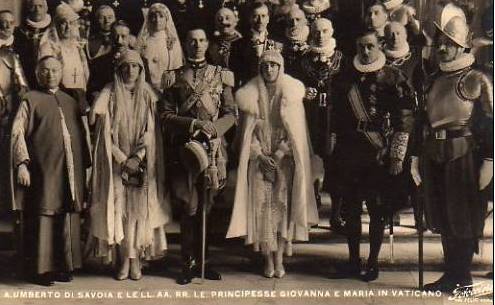
Crown Prince Umberto of Italy with his sisters Maria and Giovanna in the Vatican, along with Marquis Don Giovanni Battista Sacchetti, Major of the Apostolic Palace.
As the aristocracy’s political power declined, its social and economic standing followed the same trend, albeit more slowly. At the turn of the century, the nobles were still at the apex of the social structure, due to their rural and urban properties; their castles, palaces, and artistic treasures; the social renown of their names and titles; and to the excellent moral and cultural values of their traditional household environments, manners, lifestyle, and so on.
The crises resulting from World War I brought some changes to this picture. They deprived part of the noble families of their means of livelihood and forced many of their members to secure subsistence through the exercise of professions at variance, even when honest and worthy, with the psychology, customs, and social prestige of their class.
On the other hand, contemporary society, increasingly shaped by finance and technology, produced new relations and situations as well as new centers of social influence that were usually alien to the aristocracy’s traditional surroundings. Thus, a whole new order of things arose alongside the surviving old one, further diminishing the nobility’s social importance.
Finally, to all this was added an important ideological factor, also detrimental to the nobility. The worship of technological progress (4) and the equality proclaimed by the Revolution of 1789 tended to create an atmosphere of hatred, prejudice, defamation, and sarcasm against the nobility, which is founded upon tradition and transmitted in a way that egalitarian demagoguery most hates: by blood and cradle.
World War II brought additional and more extensive economic ruin to many noble families, worsening yet further the multiple problems the aristocracy had to face. In this way, the crisis of a great social class became acute and firmly entrenched. It was with this picture before him that Pius XII addressed the current situation of the Italian nobility in his allocutions to the Roman Patriciate and Nobility, which had obvious relevance for all the European nobility.
_______________
2. Pius XII and the Roman Nobility
This situation, and particularly the way it affected the Roman Nobility, was know to Pius XII in all its details.
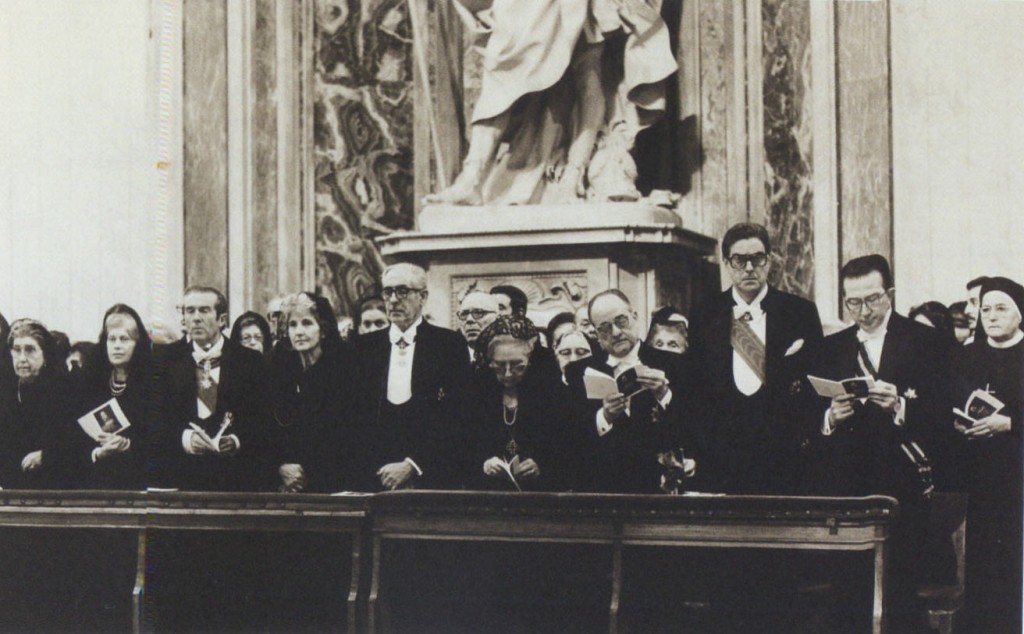
At the funeral of Pope Pius XII, right to left: Mother Pascalina Lehnert, the Honorable Andreotti, the Marquis Sacchetti, Mayor Cioccetti of Rome, the Pope’s nephews Marcantonio and Giulio with their wives.
He belonged to a noble family, whose sphere of relations was naturally among the nobility. In 1929, one prominent member of his family was graced with the title of marquis; and the Pope’s nephews, Don Carlo Maria, Don Marcantonio, and Don Giulio Pacelli, each received the hereditary title of prince from King Victor Emmanuel III of Italy.
There was something imponderable in that Pope which evoked nobility: his tall, slim bearing, his way of walking, his gestures, even his hands. This Pontiff, so universal in spirit and so friendly to the lowly and poor, was also very Roman and had his attention, consideration, and affection also turned toward the Roman Nobility.
[quote from: RPN 1941, p. 363.]_________________
3. The Universal Scope of the Allocutions of Pius XII to the Roman Patriciate and Nobility
Having thus enunciated the theme, it may seem at first glance that the allocutions to the Roman Patriciate and Nobility are of interest to Italy alone.
In reality, the crisis undermining the Italian nobility also affects, mutatis mutandis, all the countries with a monarchical and aristocratic past. It also affects those countries presently living under monarchical regimes whose respective nobilities find themselves in a situation analogous to that in Italy before the fall of the Savoy dynasty in 1946.

The fall of the Savoy dynasty. Voters go to the polls in Rome for the 1946 referendum on the choice between the Monarchy or the Republic.
Even in countries with no monarchical past, aristocracies were constituted by the natural course of events, in fact if not in law. In these countries, too, the wave of demagogic egalitarianism born of the 1789 Revolution and brought to its height by communism, created in certain environments an atmosphere of resentment and misunderstanding in relation to the traditional elites.
The allocutions of His Holiness Pope Pius XII thus have a universal scope.
This scope is enhanced by the fact that, in his analysis of the Italian situation, the Pope rises to high doctrinal considerations and, therefore, reaches a perennial and universal dimension. An example of this is his allocution of December 26, 1941, to the Pontifical Noble Guard. From considerations about the nobility, Pius XII ascends to the highest philosophical and religious reflections:
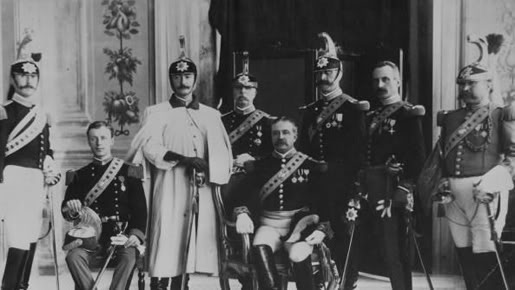
Picture of a few of the soldiers of the Papal Noble Guard: The Commanding General, along with the Colonel and two Brigadier Generals.
“Yes, faith renders your rank more noble still, for all nobility comes from God, the noblest Being and source of all perfection. Everything in Him is nobility of being. When Moses, sent to deliver the people of Israel from Pharaoh’s yoke, asked God atop Mount Horeb what should be the name whereby He would be made manifest to the people, the Lord replied to him: “I am Who am: Ego sum qui sum. Thus shalt thou say to the children of Israel: He Who is—Qui est, hath sent me to you” (Exod. 3:14). What, therefore, is nobility? “All nobility of any thing,” teaches the Angelic Doctor Saint Thomas Aquinas, “appertains to it in accordance with its being; indeed the nobility that man gains from wisdom would be nothing if through such wisdom he were not made wise; and so it is with the other perfections as well. Therefore the measure of a thing’s nobility corresponds to the measure in which it possesses being, inasmuch as a thing is said to be more or less noble according to whether its being is restricted to a particularly greater or lesser degree of nobility…. Now God, who is His being, possesses being in accordance with all the virtue of being itself; thus He cannot lack any nobility that belongs to any thing” (Summa Contra Gentiles, 1, I, q. 28).
“You too have being from God; He it was who made you, and not you yourselves—”Ipse fecit nos, et non ipsi nos” (Ps. 99:3). He gave you nobility of blood, nobility of valor, nobility of virtue, nobility of faith and Christian grace. Your nobility of blood you place at the service of the Church and employ in the defense of Saint Peter’s Successor; it is a nobility of good works by your forebears, which will ennoble you as well if day by day you take care to add to it the nobility of virtue…. Indeed nobility joined with virtue shines so worthy of praise that the light of virtue often eclipses the glimmer of nobility; and oftentimes in the annals and halls of the great families, the name of virtue alone remains the sole nobility, as even the pagan Juvenal did not hesitate to assert (Satyr.VIII, 19-20): “Tota licet veteres exornent undique cerae atria, nobilitas sola est atque unica virtus” [Even though old wax figures adorn the palaces of the great families on all sides, their only and exclusive nobility is virtue].” (Pius XII, 1941 Allocution to the Pontifical Noble Guard, 337-38.)
________________________
(1) This chapter, dealing particularly with the Italian nobility, is necessary to understand the allocutions of Pius XII commented herein. Still, these allocutions will also interest the aristocracies worldwide, as we have emphasized and shall reaffirm (Chapter 1, 2, and Chapter II, 3)
Throughout this work, the author has in mind, in a general way, the nobility and analogous traditional elites of Europe and the Americas. Naturally, he illustrates of documents his assertions with historical examples. Regarding the European nobility, these examples refer more often than not to the nobilities of France, Spain, and Portugal, or – inevitably – to the Roman Nobility. To give examples of every European nobility would greatly overburden the present work. This would be the case even if the author were to limit himself to adding but four nobilities – those of Italy, Austria, Germany, and England – that played roles of primordial importance in European history and culture. Indeed, the admirable plurality of aspects of the European nobilities would demand a special edition of this book for each, containing examples of their respective origins, development, and decadence. The author may yet undertake this work, if his duties as president of the National Council of the Brazilian Society for the Defense of Tradition, Family and Property (TFP) allow the necessary respite.
(2) The Treaty of February 11, 1929…
(3) To facilitate the study of the pontifical allocutions herein commented, addressed to the Roman Patriciate and Nobility and, in some way, to the Italian nobility at large, it is useful to say something of the nobility’s status in the successive constitutions of unified Italy, both monarchical and republican.
The Albertine Statute, in force until 1947, was the constitution of the kingdom of Sardinia promulgated on March 4, 1848, by King Charles Albert. This statute was successively enforced in all the states annexed by that kingdom and was later adopted as the constitution of unified Italy. Regarding titles of nobility, it established:
Art. 79 – “The titles of nobility of those who have a right to them are hereby upheld. The King may confer new titles.”
Art. 80 – “No one may received decorations, titles, or pensions from a foreign power without the authorization of the King” (Statuto del Regno, annotated by Carlo Gallini [Turin: Unione Tipografico Editrice, 1878], p. 102).
The Italian Constitution of 1947, in turn, establishes in its Transitional and Final Provisions:
Art. 14 – “Titles of nobility are not recognized.”
“The predicates of those noble titles existent prior to October 28, 1922, are valid as part of the name.”
“The Order of Saints Mauritius and Lazarus is preserved as a hispitalary entity and will function in the manner prescribed by law.”
“The law orders the suppression of the College of Heraldry” (Constituzione della Repubblica Italiana, Gazzetta Ufficiale, no. 290, December 27, 1947, pp. 45-46).
The “predicate” of the title is made up by the name of the old territory appended to the family name (as, for example, Prince Colonna di Paliano). The constitution of 1947 authorizes this compound name to appear in documents as long as it predates fascism.
As far as the author knows, the College of Heraldry of the monarchical era was a specific tribunal for cases of disputed titles, coats of arms, and the like. It has been replaced by the Italian Nobility Corps, which, without legal force but with great moral and historical authority, has an advisory panel for the admission of members to entities such as the Knights of Malta, the Cicolo della Caccia (the Hunting Society), the Circolo degli Scacchi (the Chess Society), and so on.
No form of political or tax privilege for nobles is recognized, either by the old or the new Italian constitutions since the Albertine Statue recognized the nobility only as a mere reminiscence of the past.
(4) The expression may appear a bit exaggerated to some readers. They will find it useful to consider the comments of Pius XII regarding this in his 1953 Christmas radio address cited in Chapter V, 3 c.
Plinio Corrêa de Oliveira, Nobility and Analogous Traditional Elites in the Allocutions of Pius XII: A Theme Illuminating American Social History (York, Penn.: The American Society for the Defense of Tradition, Family, and Property, 1993), 17-23.
